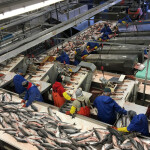Beware, Lake Michigan. Same to you, Gulf Intracoastal Waterway, for the Asian carp could well be on its way. Some reports say it’s already there. The invasive species, introduced to Midwest U.S. waterways as early as the 1970s, continues to adapt to new environs like brackish waters. Scientists seeking to stem its encroachment into areas where it could devastate native species are running out of answers.
Gates, dams or electric barriers? The fish, also known as the silver carp, can jump over them, or they were built too late. The Army Corps of Engineers has fought mostly a losing battle thus far, despite millions of dollars spent on projects to keep the fish, which can grow up to 100 pounds each, out of sensitive places like the Chicago Area Waterway System. If the fish does reach the Great Lakes or the Gulf of Mexico and thrives, many fear the silver carp will outcompete everything else for food. The herbivores’ main diet is plankton and algae, the foundation of the aquatic food web.
It all begs one obvious question: Why don’t we just eat them and control the population that way?
That’s what Chef Philippe Parola, a Le Cordon Bleu de France commander who’s served two former U.S. presidents, has in mind. But Parola admits it’s been a tough sell. Asian carp, which he calls Silverfin (www.silverfincraze.com), is chock full of bones, a fact that doesn’t appeal to many buyers.
“The bones, the bones. The only issue is the bones, my friend,” says Parola, who repeatedly describes the silver carp’s flavor as “incredible” and comparable to cod or crabmeat. When Parola does find someone willing to give the fish a try, he says they usually ask for seconds — especially children, who don’t lie about food.
Click here to read the full story from the February issue of SeaFood Business magazine >





